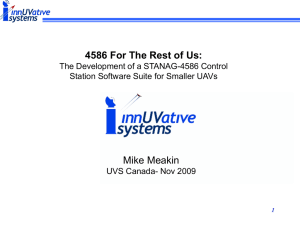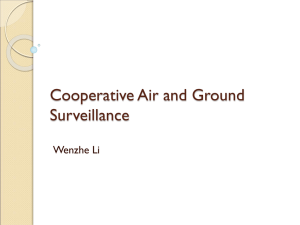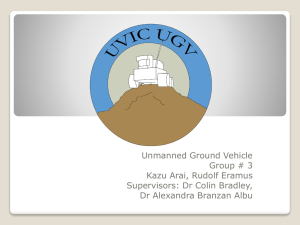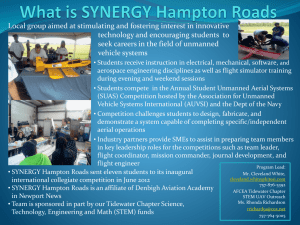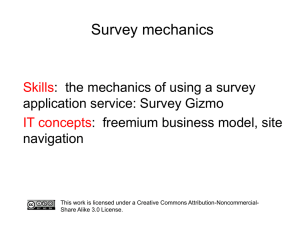Neural Nets for UGV Recon - Michigan Technological University
advertisement
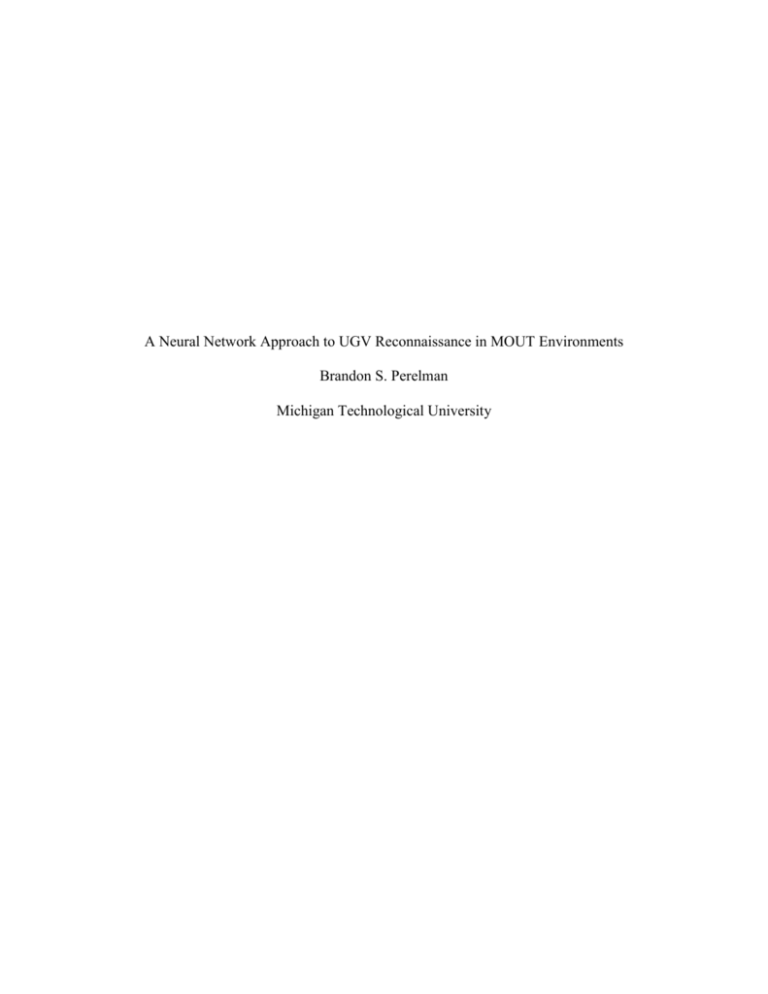
A Neural Network Approach to UGV Reconnaissance in MOUT Environments Brandon S. Perelman Michigan Technological University Abstract One important trend in unmanned systems technology is the push for increased automation. Many UGVs are currently tele-operated, and attempts have been made to automate individual components of the work burden to improve the operator-UGV ratio. This paper contains a review of the literature regarding UGV history, the tasks that automation must accomplish, challenges for automation, finally a proposition for neural network-based UGV software that would allow a micro UGV, deployed by a controller during operations in urban environments, to explore buildings and encode the environment, transmit the information to the human controller, then return. Introduction Unmanned ground vehicles (UGVs), in a dictionary sense, are ground-based mechanized systems for carrying or transporting items. UGVs specifically do not carry human operators because they are often selected specifically for jobs with qualities contraindicating human presence, such as environmental hazards, size or weight constraints, or endurance requirements (Gage, 1995). Examples of applications outside the military domain include space exploration (e.g., planetary rovers) and inspecting and assessing damage in radiological disaster sites, such as the reactors at Chernobyl and Three Mile Island (Fong & Thorpe, 2001). Early research efforts at the Stanford Research Institute, funded by the Defense Advanced Research Products Agency (DARPA), produced the first “intelligent” mobile robot, Shakey, in the late 1960s. This unit was tele-operated via radio frequency, and contained a sensor package including a video camera, a rangefinder, and touch sensors (Nilsson, 1969). Much of the initial work in the field conducted by Hans Moravec, initially at Stanford and then at Carnegie Melon University, focused on producing automation (for a comprehensive review of the literature, see Gage, 1995). Importantly, into the late 80’s, while efforts to produce truly automated UGVs for military tasks, such as reconnaissance, surveillance, and target acquisition (RSTA), encountered funding obstacles, tele-operated UGV projects such as the Advanced Teleoperator Technology (ATT) dune buggy demonstrated to military shareholders that it was possible to remotely control ground vehicles for RSTA operations, and even remotely operate weapons systems attached to those vehicles (Hightower, Smith, & Wiker, 1986). Currently, the US military employs a number of tele-operated UGVs for a variety of missions. As of October 2006, US Army UGV systems were involved in over 11,000 incidents involving improvised explosive devices (IEDs; Nardi, 2009). iRobot’s PackBot system was used in Afghanistan as early as 2002 to explore cave complexes, and Iraq in 2003 to search for chemical weapons and conduct vehicle searches (Yamauchi, 2004). Tele-operated Military UGVs show promise for a number of tasks, including RSTA operations, countermine and EOD operations, chemical, biological, radiological, nuclear, and explosive (CBRNE) searches (Nardi, 2009), logistics (Gage, 1995), load carriage to support infantry operations (e.g., MULE and its child-robots, Boston Dynamics’ Legged Squad Support System; DARPA, 2012), and even offensive operations (e.g., the Marine Corps’ Gladiator UGV; Apostolopoulos, 2014). The remainder of this manuscript is dedicated to (1) a justification for pursuing autonomy in UGVs, a discussion of (2) approaches to automation, (3) challenges for automation, and finally (4) a proposed neural network-based system for UGV operation facilitating RSTA in military operations in urban terrain (MOUT). Why Autonomy in UGVs? Currently in the US military there is a strong push to increase the extent to which UGVs are capable of operating autonomously (Nardi, 2009). There are a number of logistical reasons for this drive. First, reducing (or eliminating) the number of human operators required to control a single system reduces cost, and potentially allows one human to control multiple systems. Second, the UGV should ideally be able to react immediately to dynamic tactical situations without taking a human controller out of the fight (Mills, 2007). Third, a human controller requires an interface with which to control the UGV, which increases costs. Fourth, perceptual data from the UGV must be transmitted to the controller, and commands must be then transmitted to the UGV. Signal lag in this loop and perceptual limitations imposed by the UGV’s sensor package necessarily inhibit the controller’s ability to make control decisions, compared with an autonomous system that can make decisions without the lag associated with transmitting and interpreting information. Finally, research in the unmanned aerial vehicle (UAV) domain (e.g., Mellinger, Michael, & Kumar, 2012) with highly agile UAVs indicates that autonomous systems are capable of highly aggressive maneuvers that are simply too fast and complex for even well trained humans to execute reliably using tele-operation. Tele-operation Interface Constraints Tele-operation interfaces may be classified into four systems. In direct interfaces, the operator controls the UGV from the “inside out,” controlling the UGV with hand controllers and receiving information from the UGV typically in the visual modality. This method of control requires very high bandwidth low delay communication because video data often contains a great deal of information. Multimodal / multisensor interfaces provide the operator with a variety of control modes (e.g., individual actuator control versus coordinated motion) and multiple displays (i.e., text and visual information). These interfaces combine information from multiple sensors or data sources to present a single integrated view, and are appropriate for applications where the remote task environment (e.g., satellite service in space, or volcano exploration) is too complex to perceive in a way that allows sound decision making. Multimodal / multisensory interfaces are used to control many High Altitude Long Endurance UAVs, such as Predator. Novel interfaces include all “other” types of interfaces, with examples including haptic control, gesture control, and hands-free brainwave-based methods. Finally, supervisory control describes a scheme in which the operator divides a control problem into a sequence of subtasks that the robot executes autonomously. Supervisory control may be thought of as a bridge between teleoperation and automation (Fong & Thorpe, 2001). Currently, the majority of UGVs in the US arsenal are tele-operated, and the US military’s tactics, techniques, and procedures (TTPs) for employing UGVs reflects this state (Maxwell, Larkin, & Lowrance, 2013). In order to facilitate effect tele-operation, research efforts have focused on improving sensor packages (i.e., perceptual systems) and controllers (i.e., executive systems). UGV sensors are generally regarded as range-limited to the extent that operators are seldom aware of events and objects outside the UGV’s immediate surroundings. Since the UGV cannot perceive remote events, it cannot respond to them and, therefore, cannot secure larger areas (Kogut, Blackburn, & Everett, 2003). Situation awareness (SA) and workload are serious concerns for UGV operators and the effects of various manipulations on these factors have been extensively studied. In their meta-analysis, Coovert, Prewett, Saboe, & Johnson (2010) illuminated a number of factors impacting aspects of UGV operation. Some of these factors are particularly pertinent to MOUT operations. For example, complex (e.g., urban) environments are demonstrably more difficult to navigate than sparse environments (e.g., the ocean floor). The literature concerning field of view (FOV), important in constricted urban environments, is particularly inconclusive. For example, wide FOV decreases workload, improves SA, and offers task-dependent performance benefits. However, wide FOV is associated with increased motion sickness and difficulty steering. In simulations, participants required maps to carry out coarse navigation. Maps of the environment are not always available and GPS is not always reliable, and using a map requires that the controller split his attention between the map and the UGV’s sensors. Tandem control schemes have been developed (e.g., Chen, 2010; Ha & Lee, 2013) that allow a UAV to increase the UGV operator’s SA without a need for GPS, but such schemes require direct line of sight between the unmanned systems, which would be obstructed in many urban environments, and the expense of fielding an additional unmanned system. Finally, workload issues are compounded when the UGV operator has duties beyond control, such as operating weapon systems (Irvin, Leo, & Kim, 2012). To address workload issues with controlling UGVs, researchers have tested different styles of joystick (Ögren, Svenmarck, Lif, Norberg, & Söderbäck, 2013) and smartphone control schemes (Walker, Miller, & Ling, 2013). Both of these types of controllers have associated costs and rewards, however, and neither addresses the workload burden of simultaneously controlling the UGV’s movement and performing other tasks (Irvin et al., 2012). In summary, tele-operation research generally indicates tradeoffs with any conceivable interface, at best, or unrealistic expectations, at worst. Providing the speed, tactical flexibility, and small “footprint” required for MOUT operations requires automation. Current Approaches to Automation One definition of the minimum requirement for true autonomy is the “capability for both planning the vehicle course and controlling the position of the vehicle on route.” (Childers, Bodt, & Camden, 2011) For the purposes of this manuscript, the definition of true autonomy is expanded to include an unmanned system’s ability to independently achieve stated mission objectives. For example, a UGV tasked with RSTA should be capable of scouting independently and recording the necessary information to provide its commander with a comprehensive account of the situation. More recently, the Army Research Laboratory (ARL) Robotics Collaborative Technology Alliance (RCTA) has made significant progress toward this goal, which is attributable to advances in technology. Specifically, these include perceptual advances such as improved laser detection and ranging (LADAR) and other sensory devices, perceptual algorithms usable by automatons to decipher this data, path planning algorithms, and improvements in networking amongst UGVs (Childers et al., 2011). The remainder of this section comprises a review of the literature of advances as they pertain to the RSTA mission. Environment Perception A UGV’s ability to perceive the environment takes on a different quality when the unit is automated versus tele-operated. For example, human factors considerations such as motion sickness prevention due to FOV characteristics (Coovert et al., 2010) are irrelevant in the context of automated agents. However, additional programming is required to allow the unit to perceive the information that it senses. UGVs typically use some combination of vision (i.e., digital camera), LADAR, and sonar sensors to gather environmental information. Sometimes this disparate information is aggregated into a single picture (e.g., Peynot & Kassir, 2010). Each of these sensor types has its own advantages. Vision and LADAR work well over moderate distances (around 200 m) in clear weather, and can be used for water and mud detection (both serious threats to UGVs; Rankin & Matthies, 2010; Rankin, Matthies, & Bellutta, 2011), but the quality of the sensory information is easily degraded by environmental factors such as precipitation, airborne particulate, and foliage. Sonar, despite its limited range, is capable of penetrating environmental debris (Yamauchi, 2010). As the UGV senses environment information, on-board algorithms create a perceptual picture, or model, of the environment using Simultaneous Localization and Mapping (SLAM) algorithms. It is worth noting that this information is both actionable by the UGV itself, and transmissible as reconnaissance information. LADAR is primarily used to create this model, and is usable in both rural (Zhou & Dai, 2010) and urban terrain (Whitty, Cossell, Dang, Guivant, & Katupitiya, 2010). In addition to mapping static terrain, LADAR data can be used to track moving objects such as people (Navarro-Serment, Mertz, & Hebert, 2010). Tactical Behavior UGVs may act on their environmental perceptions in a number of ways, of which navigation is perhaps the most common. In most contexts, because efficiency is the goal, shortest path algorithms are commonly used. Shakey, for example, used the A* algorithm, whereas many autonomous agents in both the UGV domain and cognitive modeling use Dijkstra’s algorithm or something similar. However, in military applications, UGVs may be targeted by the enemy. Therefore, tactical planning systems are required for self-preservation. One such system by Hussain, Vidaver, and Berliner (2005) enables a UGV to use tactical behaviors to evade mobile enemies and accomplish its goals. Specifically, the Advocates and Critics for Tactical Behaviors (ACTB) system generates lists of “advocates,” situational prompts for certain tactical behaviors, and selects from amongst them based on “critics,” reward plans based upon tactical goals (e.g., minimizing risk or maximizing speed). In addition to driving locomotion, the ACTB system includes logic for aiming cameras and could presumably adapt to control weapons systems. Challenges to Automation UGV barriers to automation are typically the result of hardware, rather than software, shortcomings. Specifically, unlike UAVs, UGVs sometimes operate in environments where compass and GPS instruments cannot be used for localization. In urban environments, environmental obstacles such as stairs pose serious threats to UGV mobility. Furthermore, because they travel on a surface rather than flying, UGVs must be able to physically traverse terrain, or at least recognize when traversing terrain would be difficult or impossible. Sensor Challenges GPS is often used by UGVs for localization, while a compass instrument is used to establish current facing. Maxwell et al. (2013) describe a scenario in which semi-autonomous unmanned air, sea, and land units defended a high value target attacked by an enemy which arrived by water and then proceeding over land. The unmanned systems were tasked with identifying and tracking the attacker. In this scenario, of the two UGVs, one performed acceptably while the other experienced difficulty navigating. Specifically, the UGV’s compass readings were disrupted by electromagnetic interference from that UGV’s range finder and perhaps also vibration associated with traversing outdoor terrain. UGVs operating in urban terrain will often need to traverse terrain such as stairs, and rely on LADAR for sensing the environment, so these concerns are particularly important. GPS units suffer from dilution of precision errors when UGV-satellite line of sight (LOS) is occluded. In urban environments, UGVs will often operate inside of buildings, or in areas where buildings are sufficiently high as to occlude LOS. Finally, accelerometers and gyroscopes used by UGVs for proprioceptive information are affected by environmental conditions, such as temperature (Durst & Goodin, 2012). In summary, compass, GPS, and proprioceptive information are not robust sources of data for localization. Environmental Challenges In addition to sensor issues, the environment poses challenges for UGVs. For example, mud and water threaten UGV mobility in rural as well as urban environments. Vision algorithms (e.g., Rankin & Matthies, 2010; Rankin, Matthies, & Bellutta, 2011, respectively) can detect these threats, but rely on cues that may not be available in urban environments, such as sky reflections off of the liquid’s surface, or information from multiple sensors (e.g., stereo, visible, and multi-wave IR) working together. Urban environments carry their own specific threats to UGVs. Research carried out as part of the Safe Operations of Unmanned systems for Reconnaissance in Complex Environments (SOURCE) Army Technology Objective (Grey, Karlsen, DiBerardino, Mottern, & Kott, 2012) identified a number of urban environment-specific threats to UGVs. However, most of these threats pertain to larger UGVs operating on roads. Comparatively little research has been conducted on UGVs operating inside structures, though the main challenges appear to be stairways. In its present incarnation, the proposed automated UGV system would not necessarily be required to traverse stairs. A Way Forward As UGVs are a developing technology, authors have propositioned numerous conceptualizations of how they might be used in future conflicts. Mills (2007) suggests that UGVs will likely support troops in combat operations. Mills suggests that future UGVs will be: Heavily armed and armored Automated, with manual control the exception rather than the rule Capable of functioning independently of GPS or way-points for pathfinding Equipped with excellent IFF capability and less than lethal options for force escalation Able to recognize obstacles (e.g., fences and jersey barriers) and hazards (e.g., mud and barbed wire) Quiet Lightweight Self-destructable or otherwise unusable by the enemy Reliable Cheap Modular – payloads are expected to evolve faster than the UGV itself Interoperable Capable of tactical behavior and quickly reacting to dynamic circumstances Mills (2007) presents a view of UGVs that is far more combat-oriented than traditional approaches to automation would allow, however. Contrary to this view, the role that we propose for UGVs in MOUT operations is less combat-oriented and more focused on information gathering. Lif, Jander, & Borgvall (2006) conducted an evaluation of UGVs employed for reconnaissance during MOUT training. Rather than focusing on the capabilities of the UGV, Lif et al. (2006) focus on the needs of the military unit and how the UGV meets or impedes those needs. For example, the authors sought to answer questions such as, “Does using the UGV necessitate changes in tactics, resource allocation, or unit organization?” The results of this study indicated that UGVs improve soldiers’ ability to gather reconnaissance, unit stealth, and the utility of information gathered (as leadership can view the images directly). However, using the UGV impeded forward movement – sending the UGV into a building and following with infantry is slower than simply advancing with infantry – and its use therefore requires a calculated tradeoff between safety and speed. Finally, the main human factors concern with the UGV was whether using the UGV is worth occupying the operator who could otherwise be fighting. Therefore, the UGV should at least incorporate a capability to “return to handler.” These needs form the basis for the system proposed in the remainder of this document. Neural Networks for UGV Reconnaissance While others (e.g., Mills, 2007) have envisioned armed UGVs patrolling alongside soldiers, here I propose an autonomous UGV, deployable in groups, capable of scouting ahead of infantry in urban terrain. In this section, I will discuss the current state of our modeling efforts, and potential methods for integrating other approaches to modeling with existing technology applied to machine cognition. This proposed system is inspired by neural networks of the hippocampus that are used to approximate navigation tasks and memory in animals and humans. A number of features make neural networks particularly attractive for this task. 1. Neural networks can be used as mechanisms for both encoding and retrieving information about the environment, allowing an agent to simultaneously direct itself and provide reconnaissance information using the same computations. 2. Neural networks in navigation are often used to model the behavior of animals that depend on proximal, rather than distal, cues in the environment. The models are capable of operating using sensory input from short range, highly reliable sources that have robust analogs in robot navigation. 3. Because they encode memories, neural networks do not rely on GPS for localization. Localization is achieved by examining the environment and comparing those features with the agent’s memory for the environment. Representing the Environment In neural network models of the hippocampus, the goal is to represent the environment using biologically plausible data structures. The most basic of these data structures are “place cells” (O’Keefe & Nadel, 1978) in the cornu ammonis (CA) area of the hippocampus, which fire as ensembles when the organism is in specific locations in the environment. These models are primarily concerned with CA layers 1 and 3 (CA1 and CA3; Levy, 1989; Levy, Colbert, & Desmond, 1990), with the CA1 layer containing the contextual cues required for localization, and the CA3 layer containing a network of interconnected cells forming a cognitive map (e.g., Mueller, Perelman, & Simpkins, 2013; Samsonovich & Ascoli, 2005). CA3-CA3 interconnections code for locations between which it is possible to move (see Figure 1). In order to navigate to a particular point, the location is chosen by activating the CA1 layer, which in turn activates its corresponding CA3 location. There are a number of mechanisms for pathfinding based on the CA3 representation, the most simple of which is perhaps a spreading activation followed by a “goal scene” (Mueller et al., 2013). Figure 1. The CA1 and CA3 matrices often used in hippocampus based neural networks. In the code (e.g., Mueller et al., 2013, adapted from code originally published by Samsonovich & Ascoli, 2005), place cell layers are structured as sets of matrices: an environment grid, a recency map, a clutter matrix, a CA1 matrix, and a CA3 layer comprised of four matrices – one for each cardinal direction. The cardinal direction matrices are necessary for experiential learning (see below). This matrix set can be applied to any environment of arbitrary size but can be scaled. That is to say that, in the current configuration, all matrices are 25 * 25 cells, but this could be adapted for higher or lower resolution as necessary. The agent “learns” the environment through exploration. The cardinal direction matrices represent known adjacency and accessibility amongst cells. As the agent explores the environment, these matrices (initially all set to zero) receive positive values where the agent can move between two cells. From the standpoint of biological plausibility, the associations here represent the strengthening of CA3-CA3 connections through exploration. For example, if the agent is in cell [3, 22] and moves north, then the north matrix for cell [3, 22] receives a value of 1. These matrices may or may not be treated as symmetrical (i.e., in such a scenario, the south matrix for cell [3, 23] would also receive a positive value as the agent had just come from that location). While currently the algorithm requires movement between the cells, it could easily be modified so that mere perception is sufficient to build these associations. Through this mechanism, the agent builds up a picture of where it (or other agents) can move in the environment. Purposive Navigation Movement throughout the space can be directed using a search algorithm. One such algorithm, novelty-seeking, relies upon the aforementioned recency map to push the agent to new locations. However, if goal-directed movement is desired, the agent uses interplay between the matrices comprising the CA3-CA3 structure and the data structure representing the CA1 layer. In the model used by Mueller et al. (2013), the CA1 layer was simply a matrix containing goal locations. In other models (e.g., Gorchetchnikov & Hasselmo, 2002; Koene, Gorchetchnikov, Cannon, & Hasselmo, 2003), the CA1 structure contains all features associated with that particular context or location. In these models, the agent selects or prioritizes goal locations based upon desired features, activating the CA1 locations that contain those features. One mechanism for directing navigation to goals is spreading activation, or “goal scent.” Once the agent has selected goals, and their corresponding CA1 cells are activated, the CA1 locations in turn activate corresponding CA3 locations. From those CA3 locations, activation spreads throughout the CA3 network through CA3-CA3 interconnections, coded for by the cardinal direction matrices. Spreading activation through grids is a biologically plausible mechanism that is also used by existing navigation algorithms (cf. Whitty et al., 2010), but it is important to note that the current neural network approach differs from these algorithms in a number of ways. First, existing algorithms use computationally expensive optimization whereas spreading activation is efficient. Second, the data structures in the aforementioned network, specifically those comprising the CA3 layer, allow for asymmetries that a robot might encounter in an urban environment; for example, an environment could contain a configuration where a UGV could safely traverse through a hole in a wall in one direction, but could not return through that hole due to height differences or debris. Third, the activation map created using the spreading activation algorithm, combined with the recency map, allows the agent to use heuristics for navigation such as hierarchical strategies for route planning. Finally, the present mechanism slots most or all of the information required for purposive navigation, such as the environment matrices, the goal locations, and the features in every location, into one list data structure. Since most of these matrices overlap, they are conceptually very easy to use. Regarding this final point, I have created a system (Perelman, 2013) whereby environmental features, contained within an array, can be indexed either alone or in combination, to feed the CA1 goal layer. In short, the array acts as a filter whereby goal sites are selected on the basis of the features they contain. This information can be used either for localization or purposive navigation. One example of an environment that necessitates this is navigation through a shopping mall. If a UGV wants to determine its current location, and has learned the entire layout of a mall including all of the stores, it can localize by comparing the combination of stores (i.e., features) in its current location with all store combinations in the mall. The system is highly versatile, as anything salient and perceptible can be coded as a feature. Encoding the Environment Many biologically inspired neural network models are used to understand animals, most typically the rat. There are distinct differences between the types of environmental information that rats encode versus, for example, primates. While primates can rely upon distal visual cues (Rolls, Robertson, & Georges-François, 1997), rats rely mainly upon proximal cues. The purpose of this section is to discuss how rodent-specific models handle environment encoding, and to draw parallels between these mechanisms and currently technology. Rodent models are ideal for our proposed UGV because they are parsimonious – the same mechanism that allows environment encoding also provides tactical movement advantages. Note that while all of the assumptions made herein are based upon established theory, some interpretations of the published literature are not necessarily supported by consensus. Rats cannot localize using GPS, and they presumably do not rely on an internal compass. Rather, theories of rat navigation indicate place cell activation when a boundary is at a particular distance and allocentric direction from the rat, a process afforded by boundary vector cells (BVCs; Hartley, Burgess, Lever, Cacucci, & O’Keefe, 2000). Each BVC monitors its own receptive field, a Gaussian field with specific shape and direction, and the receptive field can change based on the shape of the environment. The rat localizes by comparing BVC activation in its current location with BVC activations it has experienced in the past (a process that is theoretically congruent with the feature-based approach to localization described by Perelman, 2013). Interestingly, longer receptive fields are in fact broader, whereas receptive fields for detecting more proximal stimuli are tighter, potentially indicating (1) overlapping levels of precision amongst all BVCs responsible for a single area relative to the rat’s position, and (2) a potentially hierarchical structure where boundaries are scanned for at various resolution and distances. These BVCs perform a function essentially identical to proximal sensors described by (Yamauchi, 2010). Typically, the sensors involved with modeling environments, using point clouds for example (Whitty et al., 2010), are very expensive because they are intended to model large environments. Using the BVC metaphor, the UGV can establish point clouds over much shorter distances as it explores the environment. Therefore, it requires lower resolution sensors. Sensors such as sonar provide sufficient sensory capability to model an environment provided that the agent remains close to boundaries that it can use to “anchor” itself in the environment, which is presumably one reason that rats tend to stick to walls when moving (Hoffman, Timberlake, Leffel, & Gont, 1999). Moving along walls also affords tactical advantages such as reduced visibility and probability of detection. There is no suggestion that an autonomous UGV should travel along walls exclusively, only that such a preference may be advantageous. Design Guidelines – A small UGV for reconnaissance in MOUT environments The proposed autonomous UGV must meet existing design recommendations and exceed tele-operated systems in terms of mission requirement fulfillment. In this section, I will discuss the proposed hardware and software, and how such a system is superior to existing systems. The present system was conceived mainly using the mission requirements described by Lif et al. (2006). Specifically, the system is designed to address problems with tele-operation. A reconnaissance UGV should, according to those mission requirements, Complete its mission without burdening a human operator Provide information parsimoniously to commanders in real time Return to its handler, and be capable of navigating to a specific location for extraction Complete its mission quickly to minimize the extent to which the system slows the rate of advance In addition, though Mills’ (2007) recommendations pertained specifically to armed UGVs, the proposed system was inspired by some of that design criteria. Therefore, the UGV should be capable of, Automation, with affordances for manual control Functioning independently of GPS or way-points for pathfinding Able to recognize and model obstacles and hazards Quiet movement and operation Reliable Cheap The proposed system addresses these design considerations in a number of ways. The proposed system is nearly entirely autonomous, though the UGV can use waypoints or even search directed by certain features (e.g., preferentially search a space for humans or weapons). Therefore, the system does not require constant monitoring or control, allowing all human operators to remain “in the fight.” Partial or complete maps can be inspected by the operator in real time, or at will. The system relies on input from highly reliable and cheap low resolution sensors. Because it depends upon context interpretation for localization, and accomplishes its mission through experiential learning, the system does not rely on GPS. Even given a partial mapping of the environment, the UGV can be directed, via waypoints, to specific locations at will. The system is also very inexpensive. Sonar sensors are cheap (i.e., < $100 USD) compared to LIDAR sensors. A single gimbaled sonar sensor is sufficient to sweep the environment. A second advantage of sonar sensors is that they are very small. Ideally, the unit would be roughly the size of a football and ruggedized (see Figure 2), so that it can be thrown through windows. The unit should be capable of transmitting without line of sight in urban environments to its operator. Since it is intended to be thrown, the unit should ideally be capable of operating while inverted, or at least have a mechanism to right itself. Since the unit is entirely autonomous, after it is thrown into the structure, it immediately begins collecting data. Beginning with a novelty-seeking random walk, the unit begins mapping the environment by logging boundaries and the locations of objects in the room. As the unit explores, it creates both a picture of the environment that is interpretable by the operator, and a means by which it can navigate to a waypoint for extraction. Figure 2. The UGV. Not drawn to scale, the UGV is expected to be small, roughly the size of a football. Interface In the proposed system, the operator would receive information from the unit by means of a handheld display that updates in real time as the unit explores the environment. The display can be monitored as the unit explores, or monitored when the operator has time to spare. Since it is constantly transmitting, if the unit is destroyed or otherwise disrupted, no information will be lost. And, since the unit does not require GPS or tele-operation to accomplish its mission, it can continue logging information even if it temporarily moves outside of the range necessary to transmit to the operator. The operator should interface with the unit through a rugged handheld device (see Figure 3). The UGV unit should have only one button: a power button used to prime the unit. This same button should not be used to power down the unit, as it could be activated inadvertently as the unit explores. Regarding the interface device, touchscreen is contraindicated, as the operator may need to use the unit while wearing gloves. A small directional pad and cursor should provide sufficient precision to set waypoints and move the field of view around the space as it is constructed, two buttons should provide zoom-in and zoom-out functionality (for the display of the plotted space), and four separate numbered buttons should allow a single display device to receive and display data from up to four separate units. Those same buttons, when pressed in combination with the power button on each individual unit, should allow the operator to sync a unit with a specific number on the display device. Figure 3. Handset for interfacing with the UGV. The plotted space itself should display as a map of the information collected by the unit. A point could indicate where the unit was activated, so that the user has a bearing on the map’s orientation. As per Figure 3, the unit’s current location within its grid space should be visible along with the environment as it is constructed via sonar. If, for some reason, the agent’s feed (via radio) is terminated, its current position should change to indicate this state (becoming a hollow circle, for example) and the map should remain as it was last constructed. This requires that a representation of the map be stored on both the unit and the display, and necessitates memory on both devices. Example of Use Scenario A squad of soldiers is tasked with investigating a house where a “be on the lookout” (BOLO) suspect is believed to be hiding. The suspect is wanted for his role in manufacturing IEDs used against coalition soldiers. Because of the possibility of armed enemy inside, and the possibility of traps inside the house, they are authorized to first investigate the structure using a number of the automated UGVs. Arriving outside the house, a two story structure, the UGV operator activates two units and throws one unit through a downstairs window and another through the window of the upper floor. Immediately, the units begin a novelty-seeking random walk to map out the environment, preferring to stick to walls as they model the rooms. They transmit the information in real time to the UGV operator’s handset. While they are exploring, the UGV operator is free to provide perimeter security as the units transmit to his handset. After a couple of minutes, the operator examines the handset and, finding that the UGVs have mapped out the space, shows the display to the patrol leader. Finding no humans within the structure, the patrol leader calls explosive ordinance disposal (EOD) professionals to the site. The structure floor plan generated using the UGV sonar data provides the EOD personnel with information that will guide their search using either a teleoperated robot or by hand. References Apostolopoulos, D. (2014). Gladiator. Carnegie Mellon – The Robotics Institute. Retrieved from http://www.ri.cmu.edu/research_project_detail.html?project_id=566&menu_id=261, February, 2014. Chen, J. Y. C. (2010). UAV-guided navigation for ground robot tele-operation in a military reconnaissance environment. Ergonomics, 53, 940-950. Childers, M. A., Bodt, B. A., & Camden, R. (2011). Assessing unmanned ground vehicle tactical behaviors performance. International Journal of Intelligent Control and Systems, 16, 5266. Coovert, M. D., Prewett, M. S., Saboe, K. N., & Johnson, R. C. (2010). Development of Principles for Multimodal Displays in Army Human-Robot Operations (No. ARL-CR651). University of Florida: Tampa DARPA. (2012). DARPA’s four-legged robots walk out for capabilities demonstration. DARPA News. Retrieved from http://www.darpa.mil/NewsEvents/Releases/2012/09/10.aspx, February, 2014. Durst, P. J. & Goodin, C. (2012). High fidelity modelling and simulation of inertial sensors commonly used by autonomous mobile robots. World Journal of Modelling and Simulation, 8, 172-184. Fong, T. & Thorpe, C. (2001). Vehicle Teleoperation Interfaces. Autonomous Robots, 11, 9-18. Gage, D. W. (1995). UGV History 101: A brief history of unmanned ground vehicle (UGV) development efforts. Unmanned Systems Magazine, 13. Gorchetchnikov, A; Hasselmo, ME (2002). A model of hippocampal circuitry mediating goaldriven navigation in a familiar environment. Neurocomputing, 44, 423-427. doi: 10.1016/S0925-2312(02)00395-8 Gray, J. P., Karlsen, R. E., DiBerardino, C., Mottern, E., & Kott, N. J. (2012). Challenges to autonomous navigation in complex urban terrain. In SPIE Defense, Security, and Sensing (pp. 83870B-83870B). International Society for Optics and Photonics. Ha, C. & Lee, D. (2013). Vision-based teleoperation of unmanned aerial and ground vehicles. In Proceedings of the 2013 IEEE International Conference on Robotics and Automation (ICRA), Karlsruhe, Germany, May 6-10. Hartley, T., Burgess, N., Lever, C., Cacucci, F., & O’Keefe, J. (2000). Modeling place fields in terms of the cortical inputs to the hippocampus. Hippocampus, 10, 369-379. Hightower, J. D., Smith, D. C., & Wiker, S. F. (1986). Development of remote presence technology for teleoperator systems. In Proceedings of the 14th Meeting of the UJNR/MFP, September. Hoffman, C. M., Timberlake, W., Leffel, J., & Gont, R. (1999). How is radial arm maze behavior in rats related to locomotor search tactics? Animal Learning & Behavior, 27, 426-444. Hussain, T. S., Vidaver, G., & Berliner, J. (2005, May). Advocates and critics for tactical behaviors in UGV navigation. In Defense and Security (pp. 255-266). International Society for Optics and Photonics. Irvin, C., Leo, S., & Kim, J. (2012). GunBot: Design concept of a semi-autonomous UGV with omni-directional mobility and auto-target tracking. In Proceedings of the Florida Conference on Recent Advances in Robotics, Boca Raton, Florida, May 2012. Koene, R.A., Gorchetchnikov, A., Cannon, R.C. and Hasselmo M.E. (2003) Modeling goaldirected spatial navigation in the rat based on physiological data from the hippocampal formation. Neural Networks, 16, 577-84. Kogut, G., Blackburn, M., & Everett, H. R. (2003). Using video sensor networks to command and control unmanned ground vehicles. SPACE AND NAVAL WARFARE SYSTEMS CENTER SAN DIEGO CA. Levy, W.B. (1989). A computational approach to hippocampal function. In R. D. Hawkins & G. H. Bower (Eds.), Computational models of learning in simple neural systems (pp. 243305). New York, NY: Academic Press. Levy, W. B., Colbert, C. M., & Desmond, N. L. (1990). Elemental adaptive processes of neurons and synapses: a statistical/computational perspective. In M. A. Gluck & D. E. Rumelhart (Eds.), Neuroscience and connectionist models (pp. 187-235). Nillsdale, NJ: Lawrence Erlbaum Assoc., Inc. Lif, P., Jander, H., & Borgvall, J. (2006). Tactical evaluation of unmanned ground vehicle during a MOUT exercise. In Proceedings of the Human Factors and Ergonomics Society 50th Annual Meeting, 2557-2561. Maxwell, P., Larkin, D., & Lowrance, C. (2013). Turning Remote-Controlled Military Systems into Autonomous Force Multipliers. Potentials, IEEE, 32(6), 39-43. Mellinger, D., Michael, N., & Kumar, V. (2012). Trajectory generation and control for precise aggressive maneuvers with quadrotors. The International Journal of Robotics Research, 31(5), 664-674. Mills, M. E. (2007). Challenges to the acceptance and proliferation of tactical UGVs. RUSI Defence Systems, 10(2), 28-30. Mueller, S. T., Perelman, B. S., & Simpkins, B. (2013). Pathfinding in the cognitive map: Network models of mechanisms for search and planning. Biologically Inspired Cognitive Architectures, 5, 94-111. Nardi, G. J. (2009). Autonomy, Unmanned Ground Vehicles, and the US Army: Preparing for the Future by Examining the Past. ARMY COMMAND AND GENERAL STAFF COLL FORT LEAVENWORTH KS SCHOOL OF ADVANCED MILITARY STUDIES. Navarro-Serment, L. E., Mertz, C., & Hebert, M. (2010). Pedestrian detection and tracking using three-dimensional LADAR data. The International Journal of Robotics, 29, 1516-1528. Nilsson, N. J. (1969). A mobile automaton: An application of artificial intelligence techniques. In Proceedings of the First International Joint Conference on Artificial Intelligence, Washington, D.C., May, pp. 509-520. Ögren, P., Svenmarck, P., Lif, P., Norberg, M., & Söderbäck, N. E. (2013). Design and implementation of a new teleoperation control mode for differential drive UGVs. Autonomous Robots, 1-9. O'Keefe, J., & Nadel, L. (1978). The hippocampus as a cognitive map (Vol. 3, pp. 483-484). Oxford: Clarendon Press. Perelman, B. S. (2013). A simple feature based approach to context in neurocomputational models of navigation. Unpublished manuscript. Perelman, B. S. & Mueller, S. T. (2013). A Neurocomputational Approach to Modeling Human Behavior in Simulated Unmanned Aerial Search Tasks. In Proceedings of the 2013 International Conference on Cognitive Modeling. Peynot, T. & Kassir, A. (2010). Laser-camera data discrepancies and reliable perception in outdoor robotics. In Proceedings of the 2010 IEEE/RSJ International Conference on Intelligent Robots and Systems, Taipei, Taiwan, October 18-22. Rankin, A. L. & Matthies, L. H. (2010). Passive sensor evaluation for unmanned ground vehicle mud detection. Journal of Field Robotics, 27, 473-490. Rankin, A. L., Matthies, L. H., & Bellutta, P. (2011). Daytime water detection based on sky reflections. In Proceedings of the 2011 IEEE International Conference on Robotics and Automation, Shanghai, China, May 9-13. Rolls, E.T., Robertson, R.G., & Georges-François, P. (1997). Spatial view cells in the primate hippocampus. European Journal of Neuroscience, 9, 1789–94 Sam, R. & Hattab, A. (2014). Improving the control behavior of unmanned ground vehicle (UGV) using virtual windows. Unpublished manuscript. Retrieved from http://www.ammarhattab.com/, January 31, 2014. Samsonovich, A. V., & Ascoli, G. A. (2005). A simple neural network model of the hippocampus suggesting its pathfinding role in episodic memory retrieval. Learning & Memory, 12, 193-208. doi:10.1101/lm.85205 Walker, A. M., Miller, D. P., & Ling, C. (2013). Spatial orientation aware smartphones for teleoperated robot control in military environments: A usability experiment. In Proceedings of the Human Factors and Ergonomics Society 57th Annual Meeting. Whitty, M., Cossell, S., Dang, K. S., Guivant, J., & Katupitiya, J. (2010). Autonomous navigation using a real-time 3D point cloud. In Proceedings of the Australasian Conference on Robotics and Automation. Yamauchi, B. (2004). PackBot: A versatile platform for military robotics. In Proceedings of the SPIE, 5422, 229. Yamauchi, B. (2010). All-weather perception for man-portable robots using ultra-wideband radar. In 2010 IEEE International Conference on Robotics and Automation, Anchorage, AK, May 3-8. Zhou, B. & Dai, X. Z. (2010). Set-membership based real-time terrain modeling of mobile robots with a laser scanner. In Proceedings of the 2010 IEEE International Conference on Mechatronics and Automation, Xi’an, China, August 4-7.
